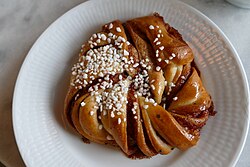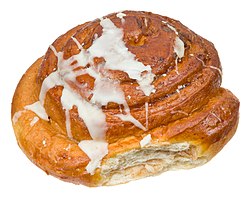Europe
In Denmark the cinnamon roll is known as kanelsnegl, in Sweden it is called kanelbulle, in Norway it is known as kanelbolle, skillingsbolle, kanelsnurr, or kanel i svingene, in Finland it is known as korvapuusti, in Iceland it is known as kanilsnúður, and in Estonia it is known as kaneelirull. [14] [15] [16] In Austria and Germany, it is called Zimtschnecke. In Slovakia and the Czech Republic, it is called škoricové slimáky/skořicoví šneci (meaning 'cinnamon snails'). [17] [18]
Since 1999, [19] [20] October 4 has been promoted as Cinnamon Roll Day (Kanelbullens dag), a national theme day, acknowledged by a significant portion of the Swedish population. [21] [22] Swedish kanelbulle dough typically also contains cardamom (powder or buds), giving it a distinctive flavour. [23]
The Swedish Butterkaka and Finnish bostonkakku ("Boston cake") is a cake made by baking cinnamon rolls in a round cake pan instead of baking them separately, so that they stick together to form a large, round cake. [24]
In Austria and Germany, they are widely available at supermarkets and bakeries. A German variety, which is similar to the Scandinavian style, originating in Hamburg and its surroundings is the Franzbrötchen , a cinnamon-filled baked good inspired by the French croissant, which does not contain cinnamon. [25]
In the United Kingdom, cinnamon bun, cinnamon roll and cinnamon swirl names are all used, and generally available in most supermarkets and bakeries. [26] [27]
Americas
American cinnamon rolls are frequently large, baked in a pan and topped with cream cheese icing (usually confectioners' sugar-based) and are sometimes fried, finished with glaze, and served as a variation of a raised donut. There are also regional combinations: in the American Midwest, especially Nebraska and Kansas, cinnamon rolls are commonly eaten with chili. [28] There are also regions that include bacon pieces. [29]
In Canada, they are known as cinnamon rolls or cinnamon buns. They are usually self-glazed and not iced, nor do they usually have raisins. [30] [31] They can have so much cinnamon that they are spicy and hot to the taste.
Asia
In Asian cultures, cinnamon rolls may be made using a yeast bread technique called tangzhong. The technique is closely associated with Japanese milk bread since it gives it a soft, feathery texture. By heating flour at exactly 65°C or 149°F, the starches within the flour will pre-gelatinize, causing it to thicken more than average. Tangzhong allows the starches to retain moisture for longer periods of time, resulting in a longer shelf life. [32]
Rolls made with tahini and cinnamon are popular in Armenian cuisine. [33] [34]











